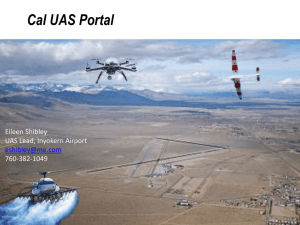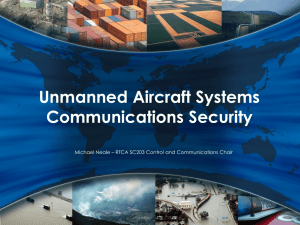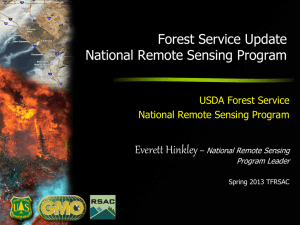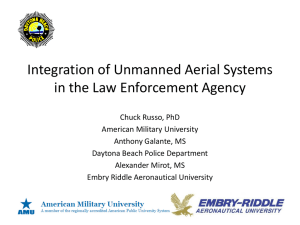UASs in the National Airspace System (NAS) Status Update
advertisement
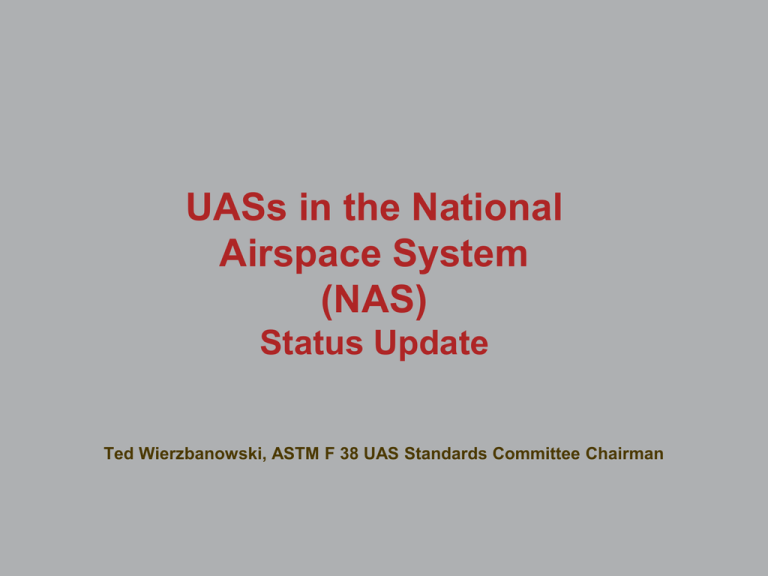
UASs in the National Airspace System (NAS) Status Update Ted Wierzbanowski, ASTM F 38 UAS Standards Committee Chairman Agenda Definitions Status update • • • • • FAA UAS organization changes FAA Modernization & Reform Act of 2012 Small UAS Overall UAS Spectrum for UAS Discussion 2 Definitions Public • Military • Non-military government (non-public safety applications) • Public safety (special non-military government case) Civil • Pure commercial (real estate, news, etc) • Support of non-military government (environmental cleanup, pipeline, etc) NOTE: Still a “gray” area! 3 FAA UAS Organization Changes Reorganization of two organizations into a single, unified UAS integration office (UAIO) under a SES now official • Unmanned Aircraft Program Office (UAPO) [Aviation Safety], and • Unmanned Aircraft Systems Group (UASG) [Air Traffic Org] Organization reporting structure: • The old UAPO was under the Flight Technologies and Procedures Division • which falls under Flight Standards Service The new (current) UAIO resides directly under Flight Standards Service Director for Policy Implications • FAA recognizing UAS are here to stay • “Much” more focus and attention to UAS • The new lead for the UAIO (Jim Williams) is very proactive and is pushing really hard to get things done and comply with Congressional direction – PRIVACY issue has negatively affected FAA ability to comply 4 FAA Modernization and Reform Act of 2012 Enacted into law on February 14, 2012 after ~24 extensions to previous authorization act • Industry (UNITE, AUVSI, AIA, and others) had significant input to the UAS specific language (started efforts in 2005/6) Subtitle B – Unmanned Aircraft Systems • Contains 16 pages • Sections, 331-336 Many tasks with timelines included 5 Reauthorization Timelines and Status May 14, 2012 • Enter into agreement to simplify the process of issuing COAs for public operators – completed for public safety entities and in process for others August 12, 2012 • Establish a program to integrate UAS into the NAS at 6 test ranges – selection • • process underway Develop plan and initiate process for designating permanent areas in the Arctic where small UAS can operate 24 hours a day for research and commercial purposes – plan completed and process underway Determine if certain UAS may be operated safely in the NAS before completion of the plan and rulemaking – in process November 10, 2012 • Comprehensive Plan to safely accelerate the integration of civil UAS into the NAS – • in process with support from UAS ARC Issue guidance regarding expanding operation of public UAS – partially completed but continues 6 Reauthorization Timelines and Status (cont) February 14, 2013 • Provide copy of comprehensive plan to Congress – completed but will be refined next • year based on implementation plan currently being completed by the UAS ARC 5 year roadmap for introduction of civil UAS into the NAS posted on web site and updated annually – will be part of comprehensive plan above and updated based on implementation plan currently being completed by the UAS ARC August 14, 2014 • Publish a final rule on small UAS – Notice of Proposed Rulemaking (NPRM) delayed • • by PRIVACY issue but looks like it is coming out “soon” Publish an NPRM to implement the recommendations of the comprehensive plan – included in the implementation plan but may be delayed Update policy statement in Docket No. FAA-2006-25714 – in process September 30, 2015 (hard date) • “No later than” date for safe integration of civil UAS into the NAS – UAS ARC developing recommended implementation plan for this. NOTE: Successful sUAS integration is being considered by the FAA as the major way it will meet the congressional mandate of safe integration of UAS into the NAS by 2015. 7 Small UAS Status Small UAS (sUAS) civil operations in the U.S. were “shut down” in Feb 2007 • Prior to this, sUAS were operated under AC 91-57 (model aircraft “rules”) • FAA issued “Clarification of Existing Policy” (Docket No. FAA-2006-25714) on 6 Feb 07 that said that operating sUAS under AC 91-57 was not legal Once that happened there were (and continues today) only two ways to fly sUAS in the NAS outside of restricted airspace • Public entities can obtain a Certificate of Waiver or Authorization (COA) with many • operational and location restrictions Civil entities can obtain an Experimental Certificate for R&D, training, and marketing (with significant restrictions and no ability to perform missions for compensation and/or hire). To help develop rules to allow more sUAS access to the NAS for civil applications, the FAA chartered a sUAS Aviation Rulemaking Committee (ARC) in Apr 2008 • sUAS ARC recommendations provided to FAA in Apr 2009 Since then, the FAA has used the ARC recommendations to develop the sUAS rule that will be published for public comment “soon” • Rule is currently in final coordination within OST/OMB • Even after it is published for public comment the rule won’t be effective for civil applications until 2014 or 2015 8 Small UAS Status (cont) Rule will reference “consensus standards” for detailed requirements (as recommended by the sUAS ARC) • ASTM has been chartered to develop the consensus standards required to implement the rule – Design, Construction, and Test. However, there are separate supporting standards in development for: Design of the command and control system Use of batteries Production Acceptance Quality Assurance Maintenance and Instructions for Continued Airworthiness Aircraft Flight Manual Operations over People (delayed until draft rule is published for public comment) – – – – – • These standards are now being drafted and are being reviewed by ASTM international membership and the FAA to ensure they meet both ASTM and FAA needs • Goal is to have the first set of ASTM final draft standards available when the rule is published for public comment In addition the FAA has asked ASTM to accelerate publication of sUAS standards so they can be used by public entities and “beta” tested prior to finalizing for civil use • ASTM is working hard to do this so it is possible the final ASTM approved standards • will be available prior to the rule being published for public comment Expect that these will have to be modified once the rule is published for public comment (only government persons have seen the actual draft rule) – However, ASTM is working with the FAA to minimize changes 9 Overall UAS Status Approval of Certificates of Authorization (COAs) for civil UAS operations in the U.S. were no longer approved after Sep 05 • Prior to this, some U.S. companies were “inappropriately” issued COAs by the FAA • without public entity sponsorship FAA issued AFS-400 UAS Policy 05-01 “Unmanned Aircraft Systems Operations in the U.S. National Airspace System – Interim Operational Approval Guidance” on 16 Sep 05 to rectify this situation Currently there are only three ways a UAS can fly in the NAS • Fly in restricted airspace sponsored by the government “owner” of that restricted • • airspace Fly under a COA (outside of restricted airspace) sponsored by the government entity that “owns/leases” the UAS and accepts the liability Fly a company owned UAS under an experimental certificate granted by the FAA for the following type missions: – – – – Research and Development Training Marketing NOTE: At the present time cannot legally fly a UAS anywhere in the U.S. for compensation and/or hire under an experimental certificate 10 Overall UAS Status (cont) Beginning in 2001 UNITE members began work on all issues involved with flying a HALE UAS in the NAS for civil applications. These efforts eventually resulted in the NASA Access 5 program that continued this work. After the NASA Access 5 program was cancelled, the FAA chartered RTCA (SC-203) to develop MASPS for larger (not just HALE) UASs in the NAS for two specific subjects: • Command and control • Sense and avoid • This work continues but is in the process of being re-focused The FAA recently chartered a new UAS Aviation Rulemaking Committee (ARC) • “This committee will provide a forum for the U.S. aviation community to discuss, • prioritize, and resolve issues, provide direction for U.S. UAS operational criteria, support the NextGen Implementation Plan, and produce U.S. consensus positions for global harmonization.” – full charter is on the FAA web site. The UAS ARC is currently finalizing a detailed recommended UAS integration plan EUROCAE Working Group 73/93 are also preparing rules/recommendations for the EU for UAS • Being done collaboratively with the FAA, RTCA, and ASTM efforts 11 Spectrum Status Spectrum for UASs is quickly becoming (or already is) the most critical issue for future UAS applications (other than the PRIVACY issue) • Public – Non-military government (law enforcement, first responders, etc) – Military • Civil (pure commercial, support of non-military government, etc) Significance of issue not universally understood • Availability of spectrum for other than US military applications • Process and extended timeline to get spectrum allocated Opportunities exist to ensure spectrum is available for UASs in the future but this requires: • Long-term commitment • Near-term support 12 Spectrum Status (cont) Spectrum allocation determined by World Radiocommunication Conference (WRC) • • • • • • • • International forum for world agreement Reviews and revises radio regulations Meetings previously held every 2 - 3 years, now extended to 4 years Operates by consensus, voting on occasion Sets the world stage for future technological development Greater emphasis on consolidated regional positions and proposals Last meeting was in Geneva in Jan/Feb 2012 Won’t meet again until 2015/2016 so…………… Process is time consuming and very “political” (like the UN) • Each of the regional spectrum organizations (see next charts) have a WRC • • • • preparatory function Administrations/nations submit draft proposals The regional organization, in accordance with their own procedures, adopt common proposals before the WRC The regional proposals are submitted to the WRC on behalf of all of their members The U.S. is part of CITEL (Inter-American Telecommunication Commission) 13 Spectrum Status (cont) North Atlantic Treaty Organization European Conference of (26) Postal and Telecommunications Administrations (CEPT) Caribbean (43) RCC Reg. Telecommunications Commonwealth in Union Comm. (15) Inter-American Telecommunication Commission (CITEL) (35) League of Arab States (LAS) (22) African Telecommunications Union (ATU) (46) Asia-Pacific Telecommunity (APT) (35) 14 Spectrum Status (cont) 15 Spectrum Status (cont) Various industry organizations worked with the US delegation to the WRC 12 to obtain spectrum for UASs • RTCA • UNITE (supported a booth at Geneva explaining value of UAS for non• • military applications) AIA AUVSI Results of WRC 12 • Line of Sight (LOS) spectrum allocated • Beyond Line of Sight (BLOS) put on agenda for WRC 15/16 • Spectrum allocated for Gateway links for High Altitude Platform Stations in certain countries Current activities • RTCA and ASTM working to develop standards to use LOS spectrum • allocation RTCA and others working on technical justification to use existing satellite spectrum for BLOS rather than aviation protected spectrum 16 Spectrum Status (cont) How does this affect small UASs? • In the US – Military applications – probably OK with current approved spectrum – Non-military applications – use “unlicensed bands” or use new dedicated LOS spectrum allocated at WRC 12 Government – might also be able to get dedicated LOS spectrum for public safety applications Non-government – use dedicated LOS spectrum allocated at WRC12 • In other countries – Military applications – probably OK provided each country provides spectrum to use – (current process) Non-military applications – use “unlicensed bands” or dedicated spectrum allocated at WRC 12 for both government and non-government applications 17 Spectrum Status (cont) How does this affect larger UASs? • In the US – Military applications – probably OK over the near term – Future military and current/future non-military applications – need new approved – spectrum for BLOS ~ Command and control ~ Will have to be in PROTECTED aviation spectrum or have similar characteristics ~ Will have to have some level of BLOS/SATCON capability in this spectrum Payload specific – most likely use already approved spectrum for the specific payload application • In transit and in other countries – Current/future military and non-military applications – need new approved – – spectrum for BLOS Common spectrum and hardware/software highly desired for interoperability and cost (ie don’t want to have to change radios, antennas, ground station components, software, etc, etc, etc for each location since this will be costly and duplicative) Working with EUROCAE WG 73/93 to enable 18 Discussion



